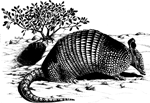Vertebrate Pest Conference: Proceedings

Vertebrate Pest Conference Proceedings: 9th (1980)
Date of this Version
March 1980
Document Type
Article
Abstract
Damage to conifer seedlings by pocket gophers (Thomomys spp.) is a major factor limiting reforestation in the western United States. To control gopher populations and reduce damage, the U.S. Forest Service annually treats thousands of hectares with strychnine alkaloid bait. Because an underground application of strychnine bait could pose a threat to other species, we monitored small mammal populations before and after a baiting operation conducted in 1979 on the Targhee National Forest, Idaho. Although two deer mice (Peromyscus maniculatus) recovered within baited areas were killed by strychnine, live-trapping revealed no differences in small mammal populations before and after baiting. Thirty yellow pine chipmunks (Eutamias amoenus) and one northern flying squirrel (Glaucomys sabrinus) were fitted with radio transmitters before treatment. Twenty-four of the chipmunks, and the flying squirrel, survived to the end of the study. Transmitter signals were lost on three chipmunks before treatment and they were unaccounted for. Two chipmunks died during the study and contained strychnine residues in body tissues. The remaining chipmunk appeared to have been killed by a predator.

